693 views
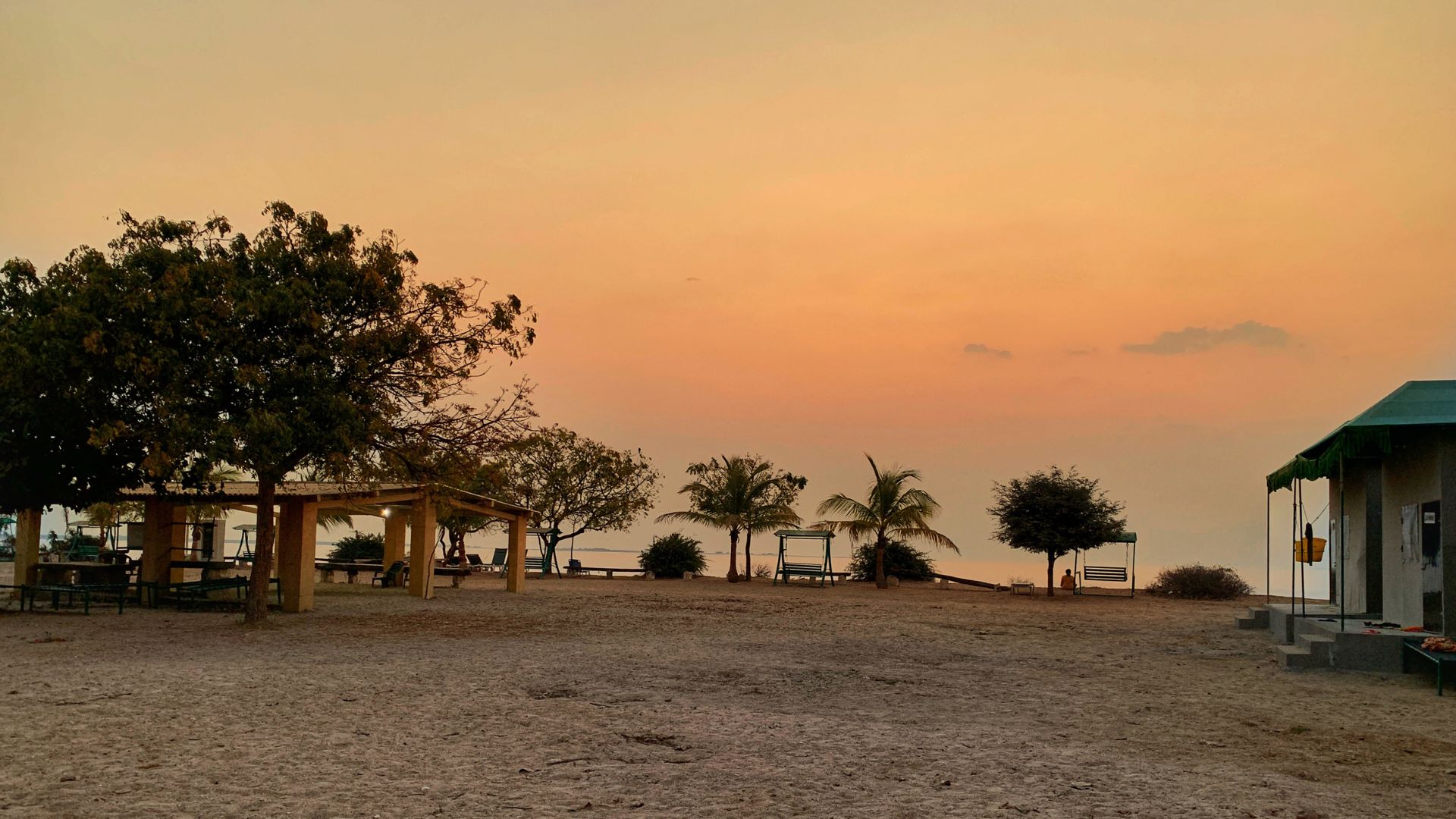
Beyt Dwarka: A Fusion of Nature and Spirituality
By Rahuldev Rajguru
Last Updated: 16 Oct 2023
For years, I had a deep desire to explore the Pirotan Island in Gujarat, a biodiversity hotspot nestled within the Gulf of Kutch. Unfortunately, my plans were consistently thwarted – first by the arrival of Covid and then by stringent government restrictions. I felt a tinge of disappointment. Then, a fellow naturalist revealed an intriguing discovery to me. He spoke of Beyt Dwarka, another gem situated in the Gulf of Kutch, boasting a spectacular marine life. His description even went so far as to suggest that Beyt Dwarka might outshine Pirotan Island in terms of biodiversity.
Eager to confirm this newfound information, I turned to google for answers. My searches yielded only information about the pilgrimage sites in Beyt Dwarka. But just when my enthusiasm was waning, a stroke of luck led me to a Facebook page of a nature camp in Beyt Dwarka - a discovery I had been fervently seeking for many years.
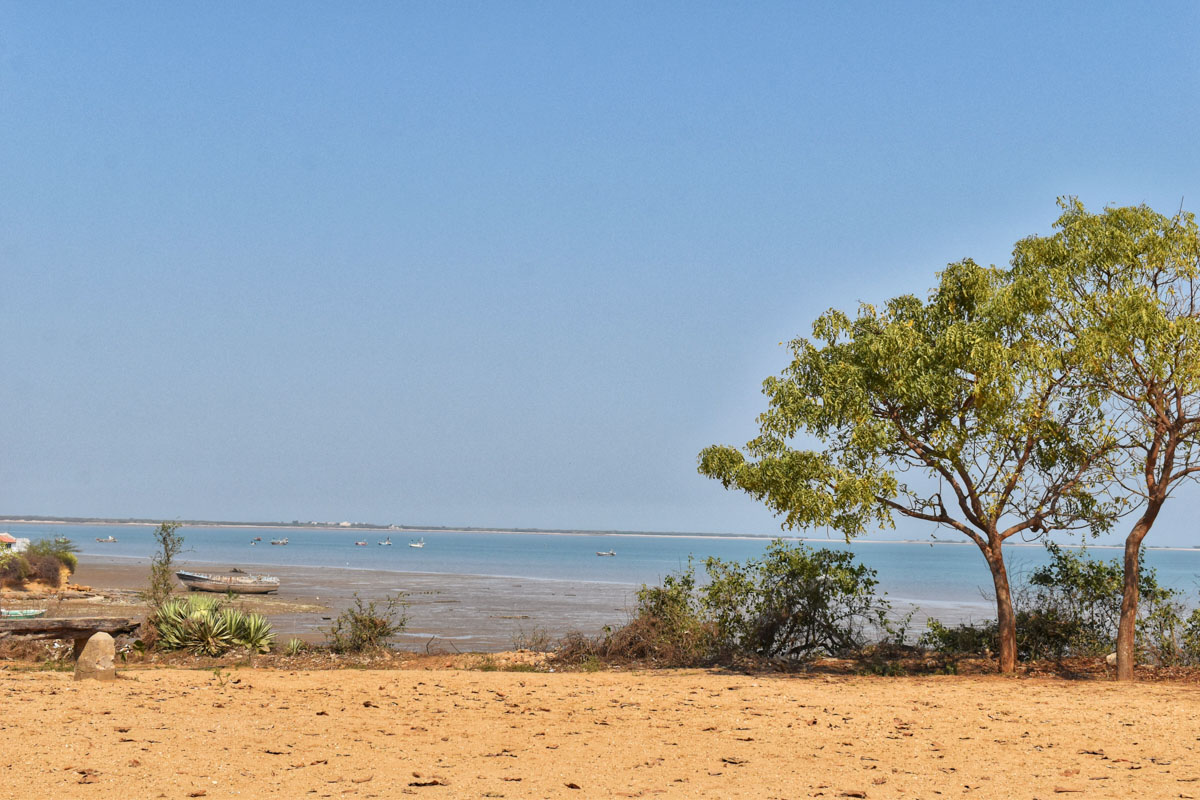
The landscape of Beyt Dwarka
I had already planned a trip to Dwarka with the intention of paying my respects at the revered Dwarkadhish temple. Seizing this moment, I recognized the golden opportunity to delve into the marine wonders of Beyt Dwarka simultaneously. Thus, commenced my expedition to this captivating biodiversity hotspot.

Beyt Dwarka: Where Legends and Devotions Merge
Beyt Dwarka, also known as Shankhodhar, emerges like a mystical gem in the Arabian Sea, its name derived from the Gujarati word 'bet,' signifying an island. Another intriguing legend traces its roots to the term 'bhet,' translating to 'gift' in Gujarati, a name resonating with the profound tale it harbors. According to Hindu mythology, Beyt Dwarka was a gift bestowed upon Lord Krishna by his childhood friend, Sudama. This tiny island in Gujarat stands as a testimony to their enduring friendship.
Taking a deep dive into its history, Beyt Dwarka reveals a story that seamlessly weaves into Hindu mythology. Here, the divine meets the earthly, where Krishna's footsteps once echoed. It's believed that this hallowed land witnessed numerous mythological episodes, each adding layers to its mystical aura. This island is not known for its coral beauty, but for the spiritual energy that permeates its soil. Beyt Dwarka stands not just as an island in the Arabian Sea but as a living testament to the enduring bond between humanity and the divine.
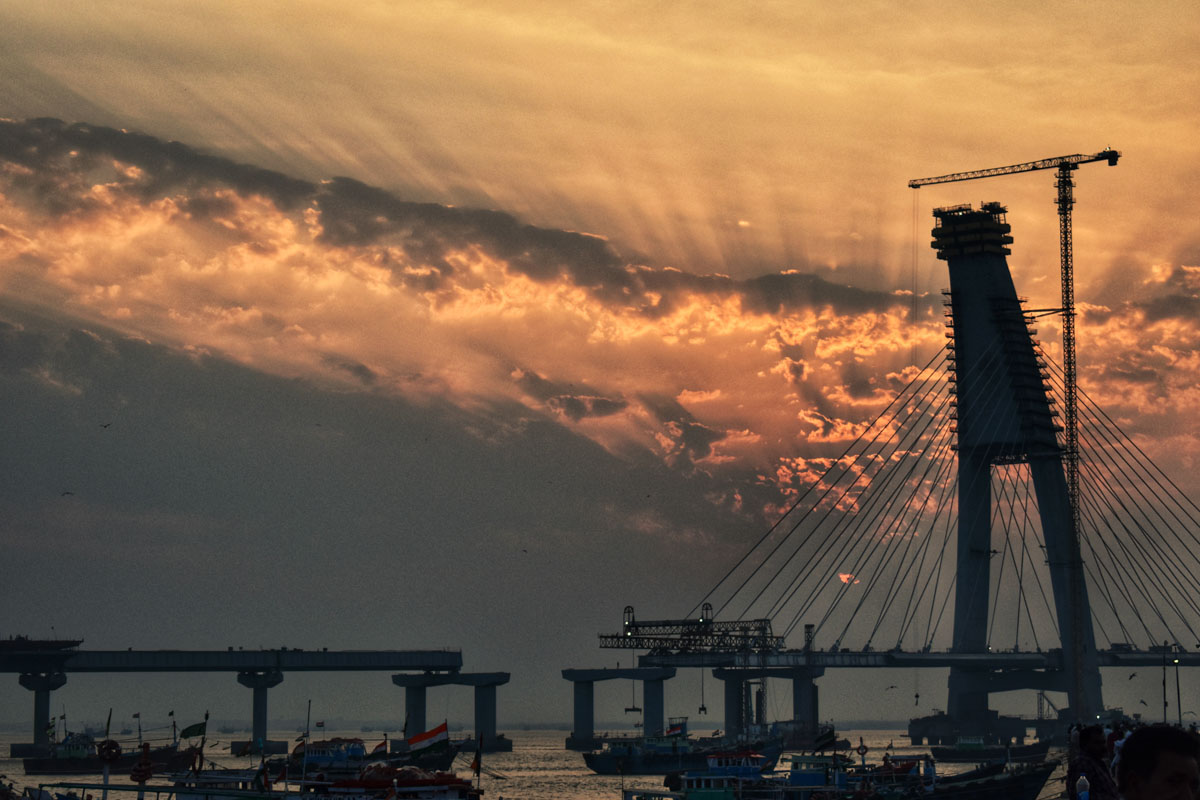
The Beyt Dwarka jetty offers a spectacular view of the sunset
A boat journey to Beyt Dwarka
Currently, the sole route to Beyt Dwarka involves a brief 15-minute ferry ride from Okha jetty. However, the landscape is on the brink of transformation. A bridge connecting Okha and Beyt is nearing completion, heralding a future where visitors can effortlessly drive to Beyt in their own vehicles. As for the ferries, there's no fixed schedule. You simply need to reach the jetty and board the next ferry in line, paying a nominal fee of INR 20 for a one-way trip. Departures occur when there are enough passengers aboard to make the journey financially viable for the boatman. For those traveling in larger groups, chartering a ferry is an option, subject to negotiation with the boatman. It's worth noting that ferry services operate between 6 am to 7 pm daily, although it's advisable to double-check the exact timings as they are subject to change.
Parking near the jetty is a bit of a gamble as there's no designated space, leaving visitors to decide whether to risk parking in the nearby area or opt for public transport from Dwarka. The jetty itself sits directly across from the Okha Railway Station, a convenient spot for those arriving in Dwarka by train. I dropped off my friend Mithilesh along with our luggage at the jetty and then drove to our family friend's house to safely park my car. A member of their family drove me back to the jetty on his 2-wheeler, where the scene was bustling, reminiscent of a vibrant fish market.
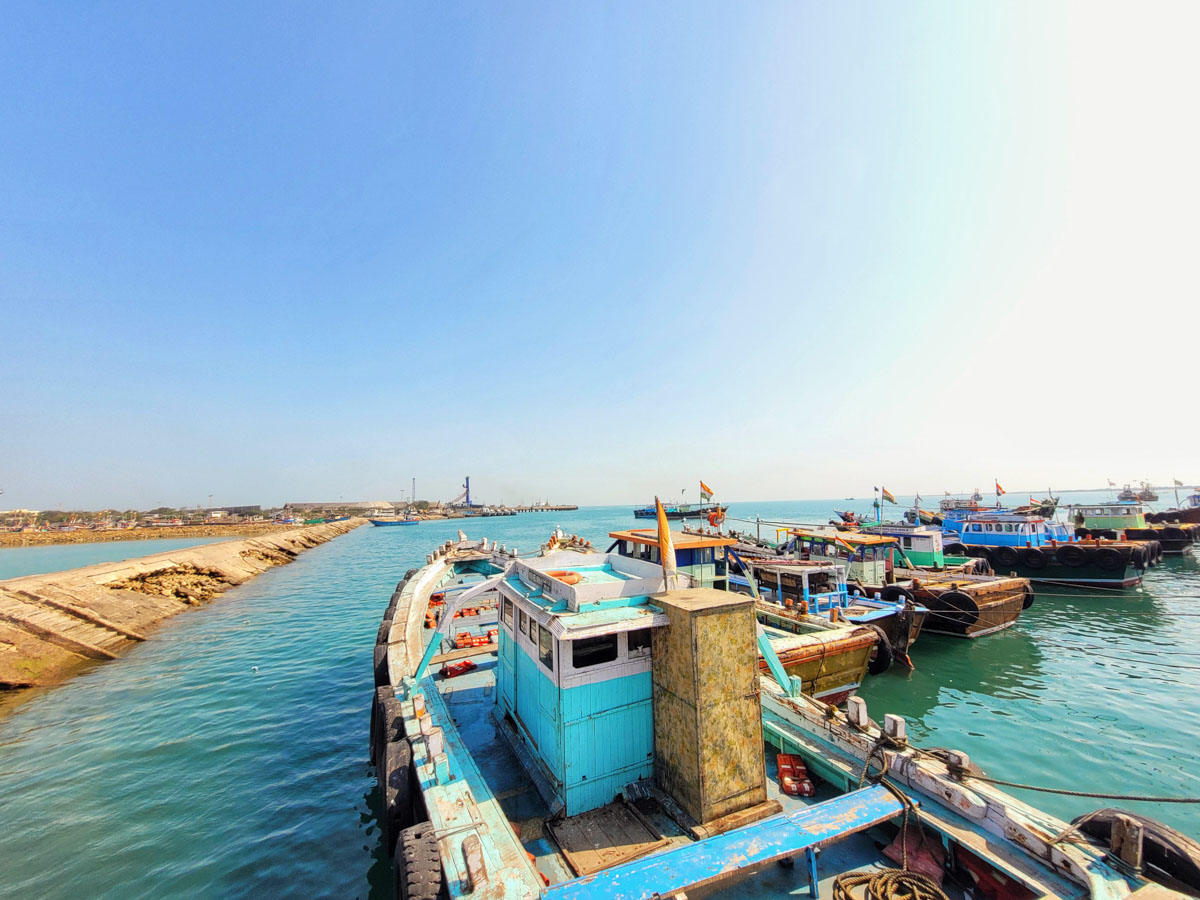
Several boats have lined up at Okha jetty in preparation to sail to Beyt Dwarka
He also brought some food for the birds, a tradition I initially found puzzling. He explained that feeding the birds is a customary experience; thousands of white seagulls are aware that each boat carries food for them. It was truly delightful to watch these graceful birds flocking between Beyt and the mainland. As you extend your hand with food, they eagerly compete for the offerings. However, there's a catch - be prepared to get sprinkled with their droppings in the process.
Embark on a boat voyage from Okha to Beyt Dwarka, surrounded by the lively squawk of seagulls as people feed them
The boat, packed to the brim with passengers, offered barely an inch of empty space. I couldn't spot any life jackets around, and even if there were some, I doubted they'd be sufficient for the considerable number of people on board. An unsettling thought crossed my mind, but then I recalled the reassurance from my neighbor whose native is Dwarka. She had shared a belief deeply ingrained in the locals: the divine protection of Lord Krishna envelopes this land. There hadn't been a single incident of a boat ferrying passengers to and from Beyt Dwarka capsizing, a testament to the unwavering faith in the safeguarding presence of the divine.
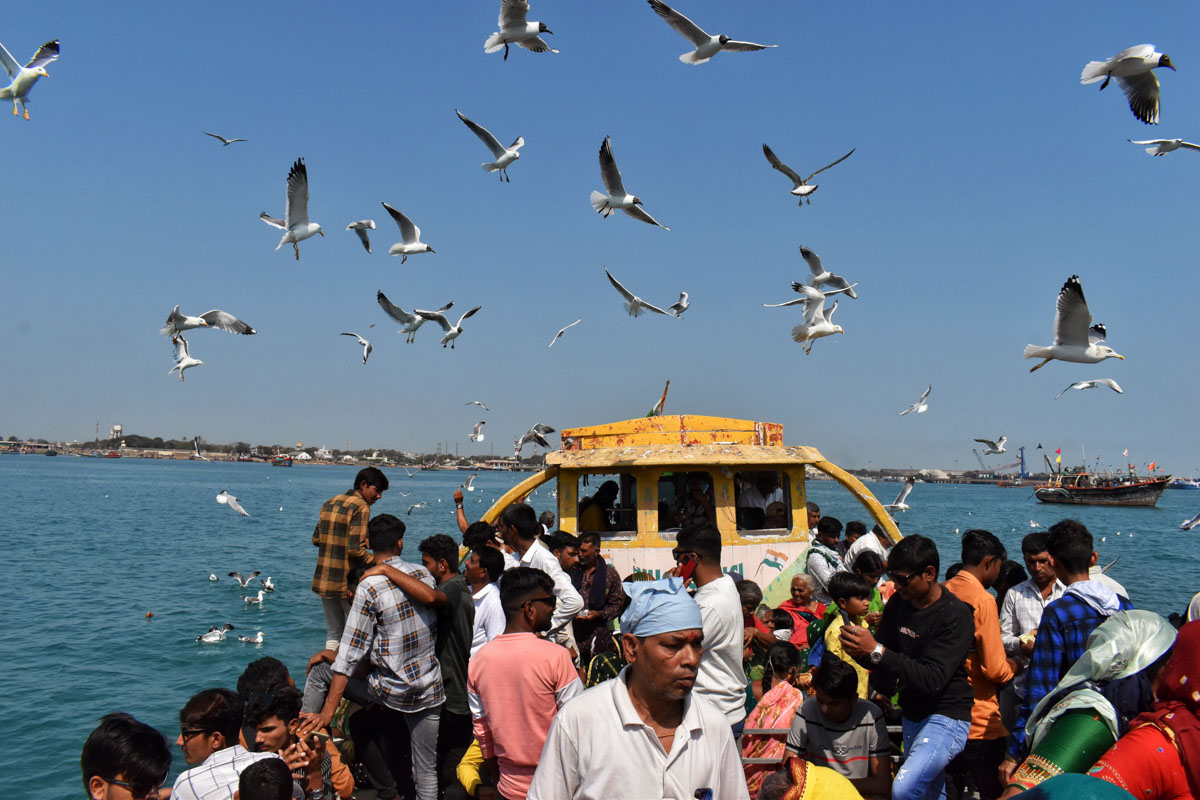
Our overcrowded boat trip to Beyt Dwarka from Okha
As our boat embarked on its journey, the mesmerizing turquoise waters stretched endlessly before us. Gradually, the seagulls departed, having secured their share of offerings. It was an opportune moment to capture the breathtaking seascape. The partially completed bridge and other boats navigating the waters provided a picturesque backdrop for my camera lens. By the time we settled into the rhythm of the journey, we arrived at Beyt Dwarka. Seagulls still lingered, wise enough to know which boats were arriving and departing. The renowned Keshavraiji temple stood proudly at the jetty, although its doors were closed upon our arrival. With a plan to return later, we decided to head back to the camp.
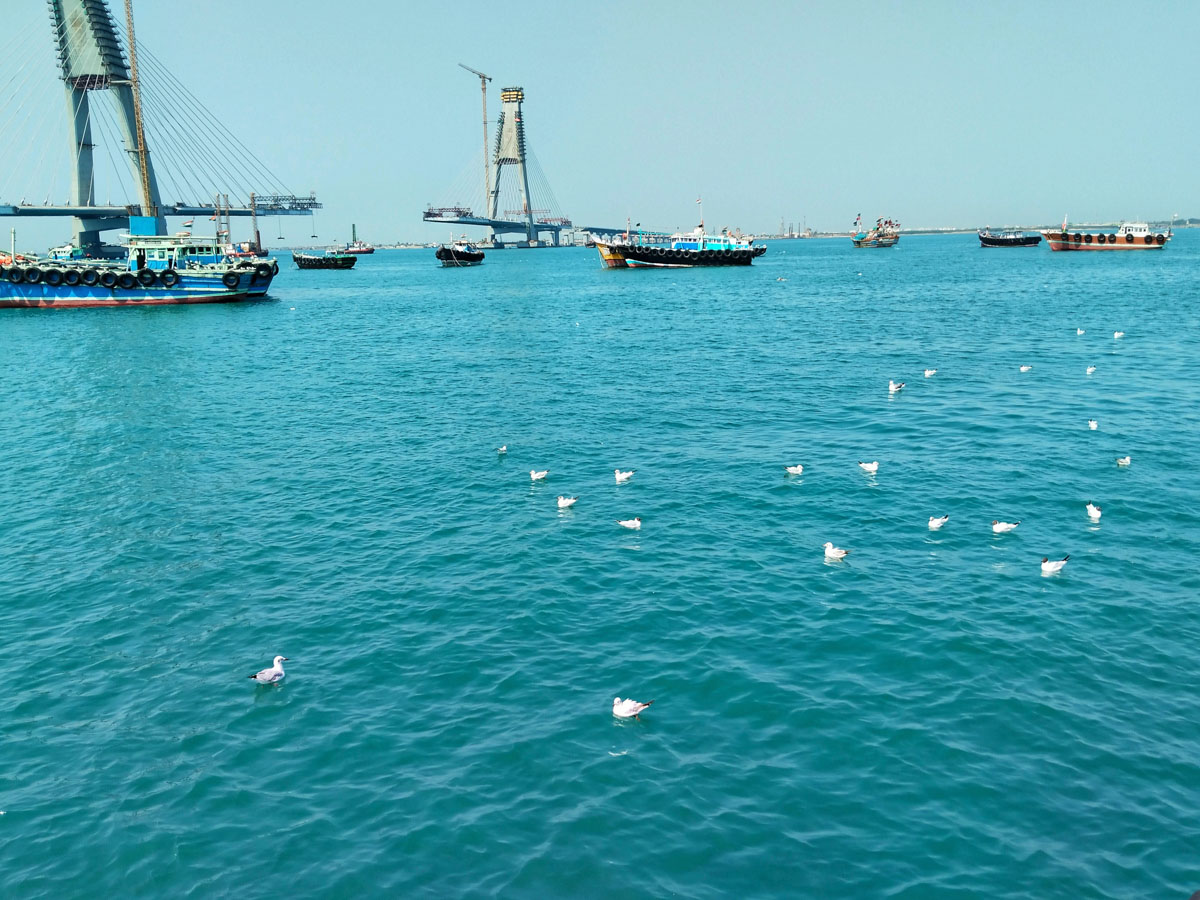
A stunning seascape from the boat
Nandanvan Camp - An oasis of simplicity and harmony in Beyt Dwarka
Nandanvan Camp at Beyt Dwarka stands as a marine education haven perched on a remote cliff, commanding a serene view of the tranquil Balapar Bay. Founded 37 years ago under the visionary guidance of renowned ornithologist Lavkumar Khachar, the camp serves as a testament to his dedication. Today, it is managed by Hemantsinh Vadher and his son Ravi Vadher, entrusted as the custodians of Panchajanya Paryavaran Trust. The name, "Panchajanya," holds profound significance, echoing the region's essence. This term refers to a species of conch abundant in the coral seas surrounding Beyt Dwarka and the thriving marine ecosystem of the Gulf of Kutch. Notably, Lord Krishna wielded the Panchajanya conch during the epic battle of Mahabharata, infusing the camp's identity with a touch of mythological grandeur.
Traditionally, most visitors to Beyt Dwarka confine their trip to temple visits, often unaware of the island's vibrant marine life. Personally intrigued by Beyt's hidden gems, I had been avidly following Nandanvan Camp on Facebook for over a year. My desire to immerse myself in Beyt Dwarka's charm for a few days grew stronger. Taking the plunge, I reached out to Ravibhai from Rajkot, and to my delight, he warmly welcomed us to the camp, despite it being occupied by a large group of school children at the same time. Remarkably, he even arranged for an auto-rickshaw to pick us up from the jetty and transport us to the camp. This gesture was incredibly helpful, considering the camp's remote location, which might have posed a challenge for newcomers unfamiliar with the area.
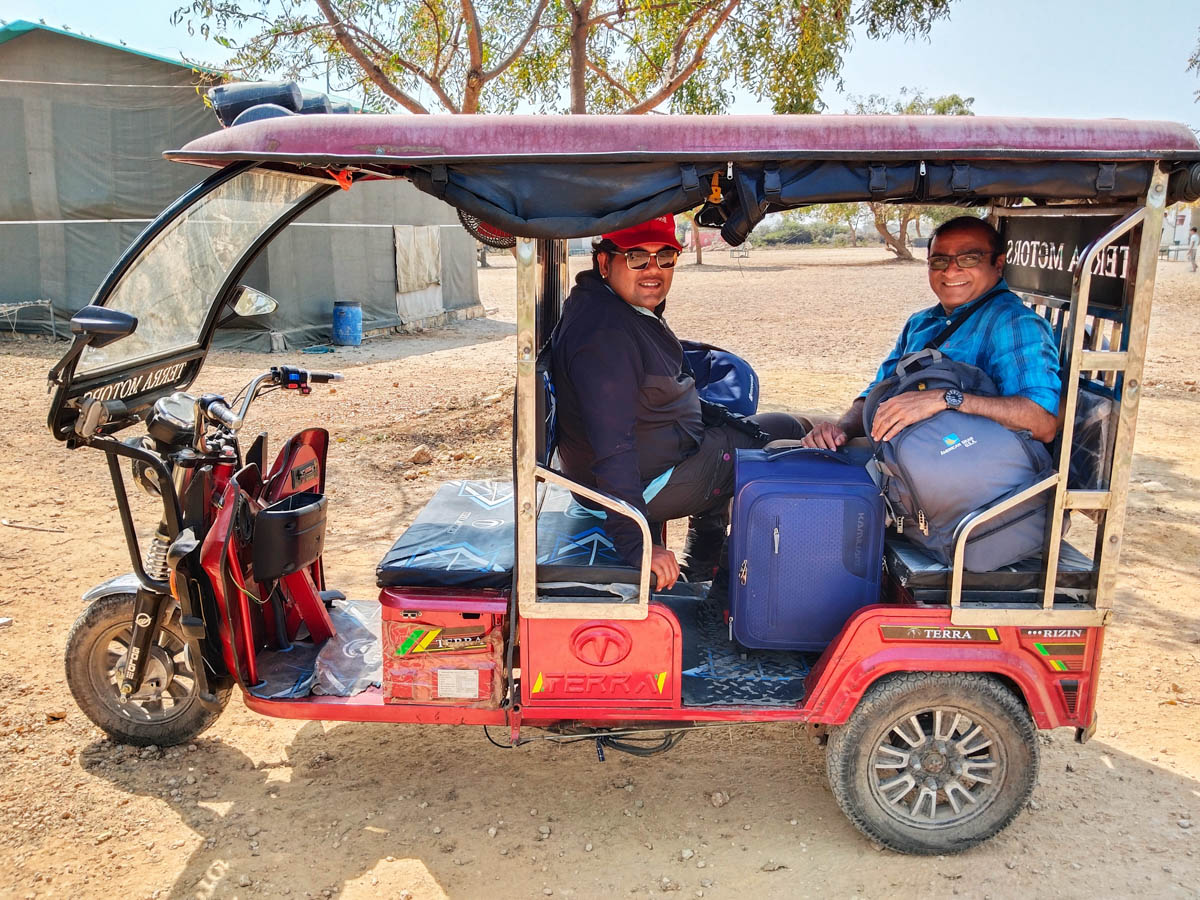
The electric auto rickshaw that transported us from the jetty to Nandanvan Camp
After navigating the winding paths within the forested expanse, we finally arrived at Nandanvan Camp. Warmly welcoming us was Hemantsinh, affectionately known as Hembha. Engaging in a lengthy conversation with him, I was profoundly moved by his humility and depth of knowledge about marine life. Having dedicated his entire life to Beyt, he emerged as the perfect guide, enlightening us about the island's ecosystem, its rich history, and the intriguing tale of the camp. Soon, a call came for lunch. Though simple, the Gujarati meal was incredibly appetizing - exactly what one craves after a long and tiring journey.

Simple but delectable Gujarati food at Nandanvan Camp
Nandanvan Camp in Beyt Dwarka epitomizes serenity and simplicity in the most enchanting manner. The rustic charm of the campsite, with its unassuming yet thoughtfully designed decor, creates an atmosphere of pure tranquility. The essence of simple living permeates every corner.
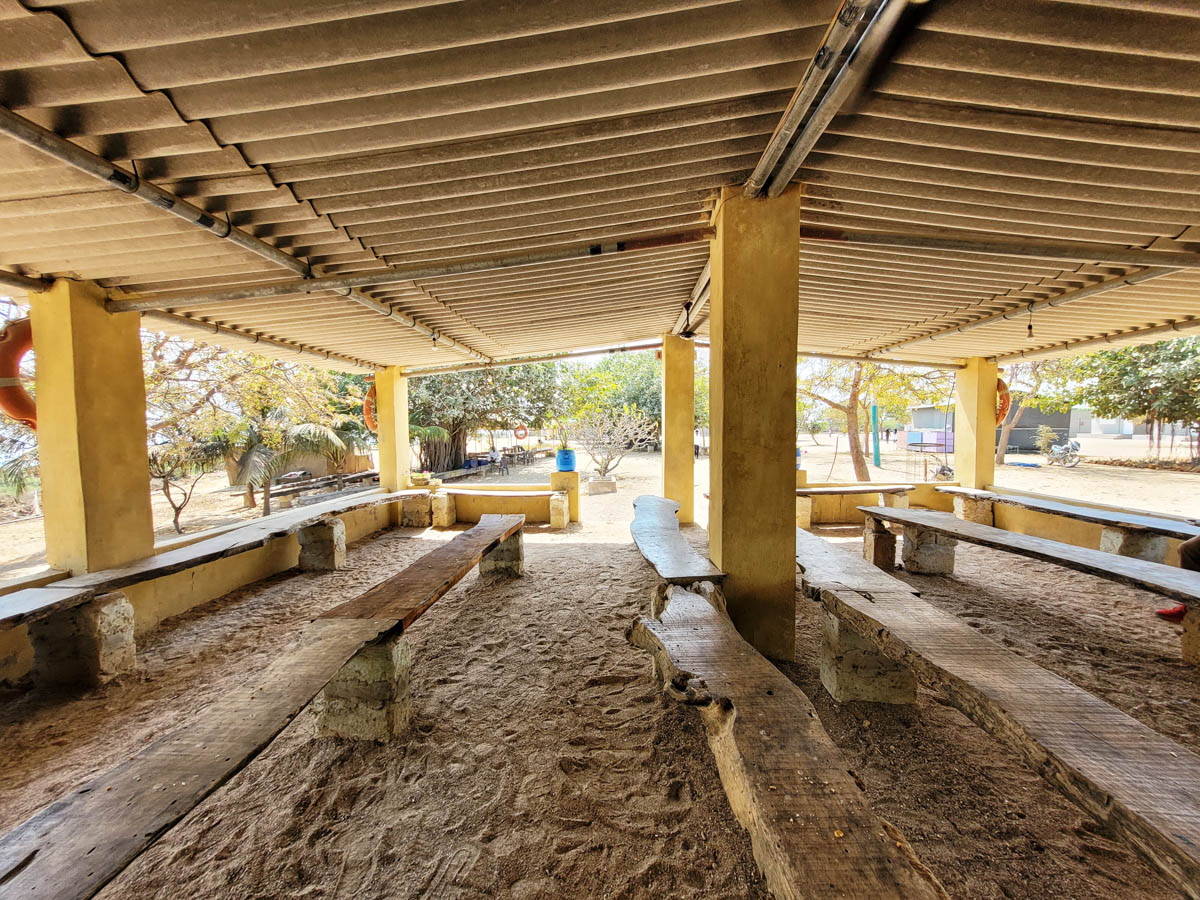
In a beautiful natural setting, a dining hall with rustic decor features beach sand flooring
The campsite opens up to a vast expanse of beach sand. The cool breeze that caresses your skin carries the invigorating scent of the sea, enhancing your sense of serenity. Each morning, the sun graces the horizon with a spectacular sunrise, painting the sky in hues of orange and pink, casting a warm, golden glow over the camp.
What truly captures the heart, though, are the benches and swings strategically placed on the edge of the cliff. From here, the view of the bay is nothing short of mesmerizing. The tranquil waters below sparkle in the sunlight, mirroring the azure sky above. The rhythmic dance of the waves and the distant cries of seagulls form a symphony that serenades the senses. It's a place where time seems to stand still, perfect for moments of deep meditation and introspection.
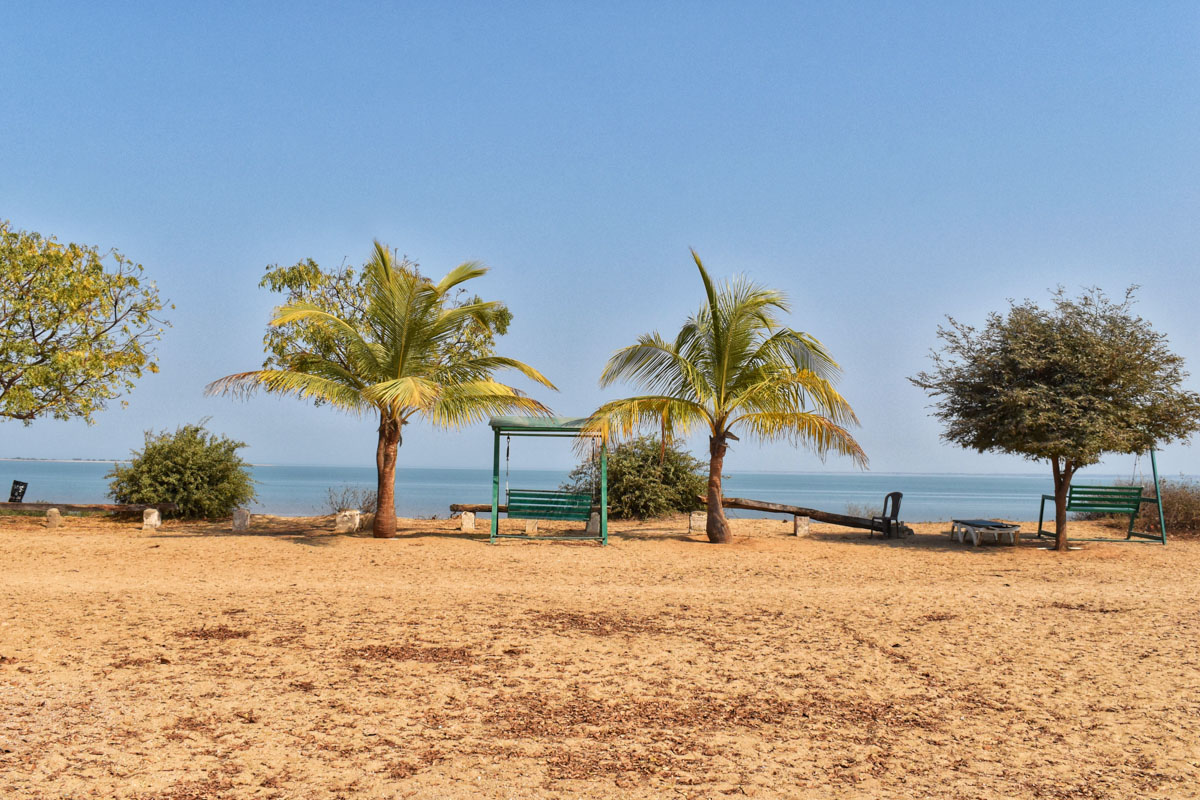
A tranquil evening at Nandanvan Camp, where nature's whispers blend with the ocean colors
In the evenings, the camp becomes a sanctuary of peace. The only interruptions come from the large waterbirds, gracefully nesting on the trees below the cliff. Their presence adds a touch of avian charm to the tranquil ambiance. And as the sun rises, the camp awakens to the delightful melody of bird chirping, a gentle reminder of the natural harmony that envelops this blissful haven.
Our assigned camp nestled near the shade of a tree, offering a welcome respite from the afternoon sun. While we had the option of setting up our beds outside or in the campsite, we chose to bask in the soothing shadow and fresh sea breeze wafting from below the cliff. Our tranquil siesta, however, was punctuated by the laughter and exuberance of school children engaged in lively games of cricket and volleyball nearby. Some of these spirited youngsters, curious about our presence, approached us with friendly greetings. Their surprise was evident when they discovered I had traveled all the way from Bangalore to Beyt Dwarka. Their queries about my fluent Gujarati, coupled with their innocent amazement, evoked hearty laughter. As these interactions unfolded, I found myself forging unexpected friendships, reminiscent of my own school days when nature tours with classmates were filled with similar camaraderie and shared laughter.
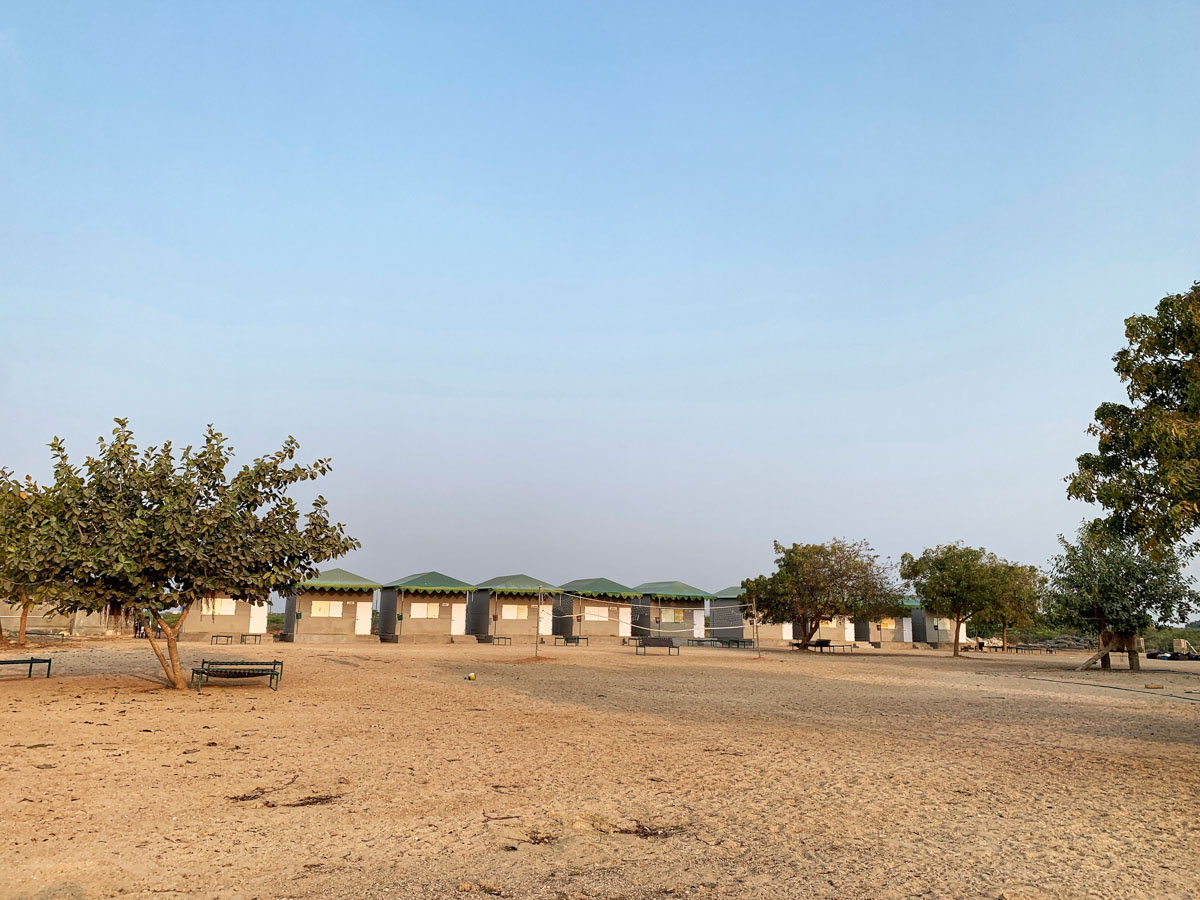
A panorama of the Nandanvan campsite's natural splendor
With the afternoon sun mellowing down and the heat becoming more bearable, it was time to embark on our adventure to discover Beyt Dwarka's marine wonders. I was curious about how they planned to transport such a sizable group of children. To my amusement, two tractors stood prepared near the camp entrance - one designated for the boys and the other for the girls. Observing the rugged terrain surrounding the campsite, it dawned on me that this practical mode of transport was essential for navigating the area efficiently. What caught my attention was the addition of large speakers and music systems mounted on both tractors. It was no surprise then that an extra layer of excitement rippled through the children. I couldn't tell if their enthusiasm stemmed more from the lively music echoing around them or the anticipation of the extraordinary marine life awaiting their exploration.
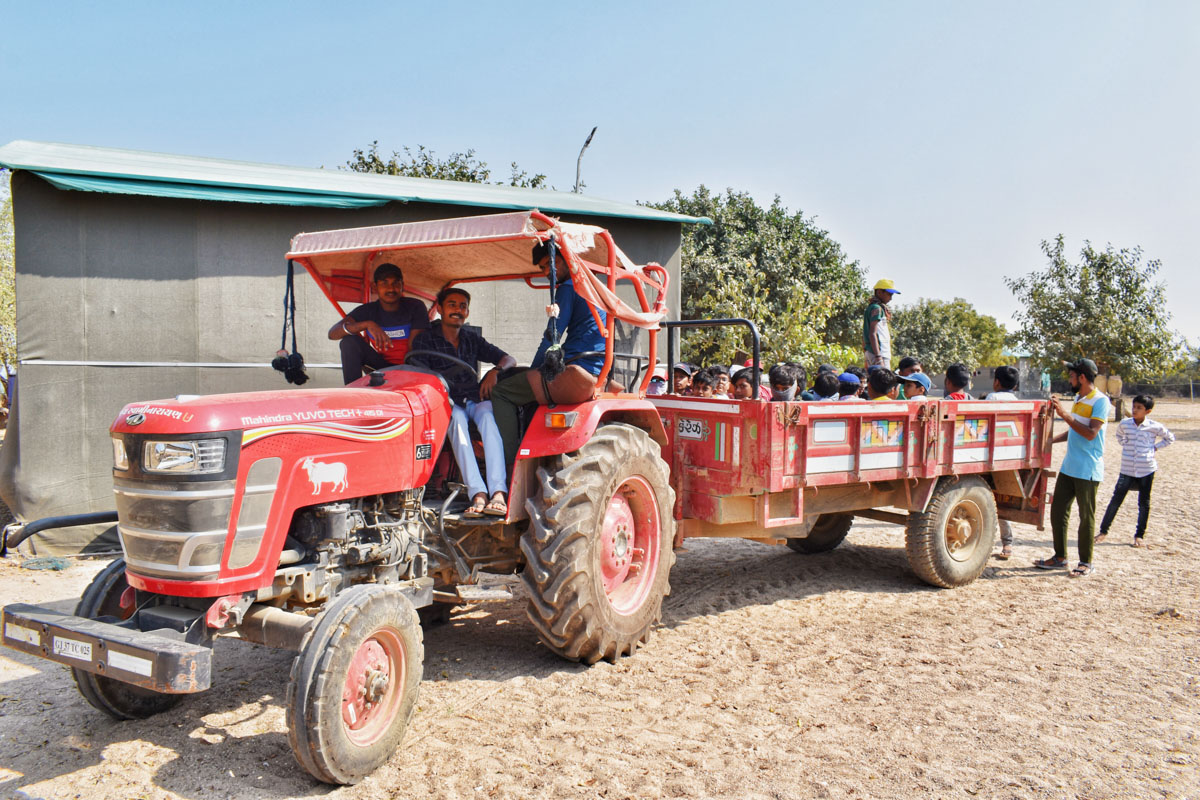
The boys are nearly on the tractor, and our journey to the beach is about to begin
As we were about to join the boys in climbing onto the trailer, Ravibhai intervened, informing us of a different arrangement. The teachers, including two of us, were directed towards a rustic and open 3-wheeler, locally known as a "chakdo" in the Saurashtra region. This decision, I realized, was a clever strategy. Separating the students from their teachers granted them a bit of extra freedom to revel in the journey. Simultaneously, it offered us an opportunity to build camaraderie with one another. Their curiosity was palpable, their questions endless, as they couldn't imagine someone from Bangalore participating in a camp in the remote corners of Gujarat. I embraced their queries with enthusiasm.
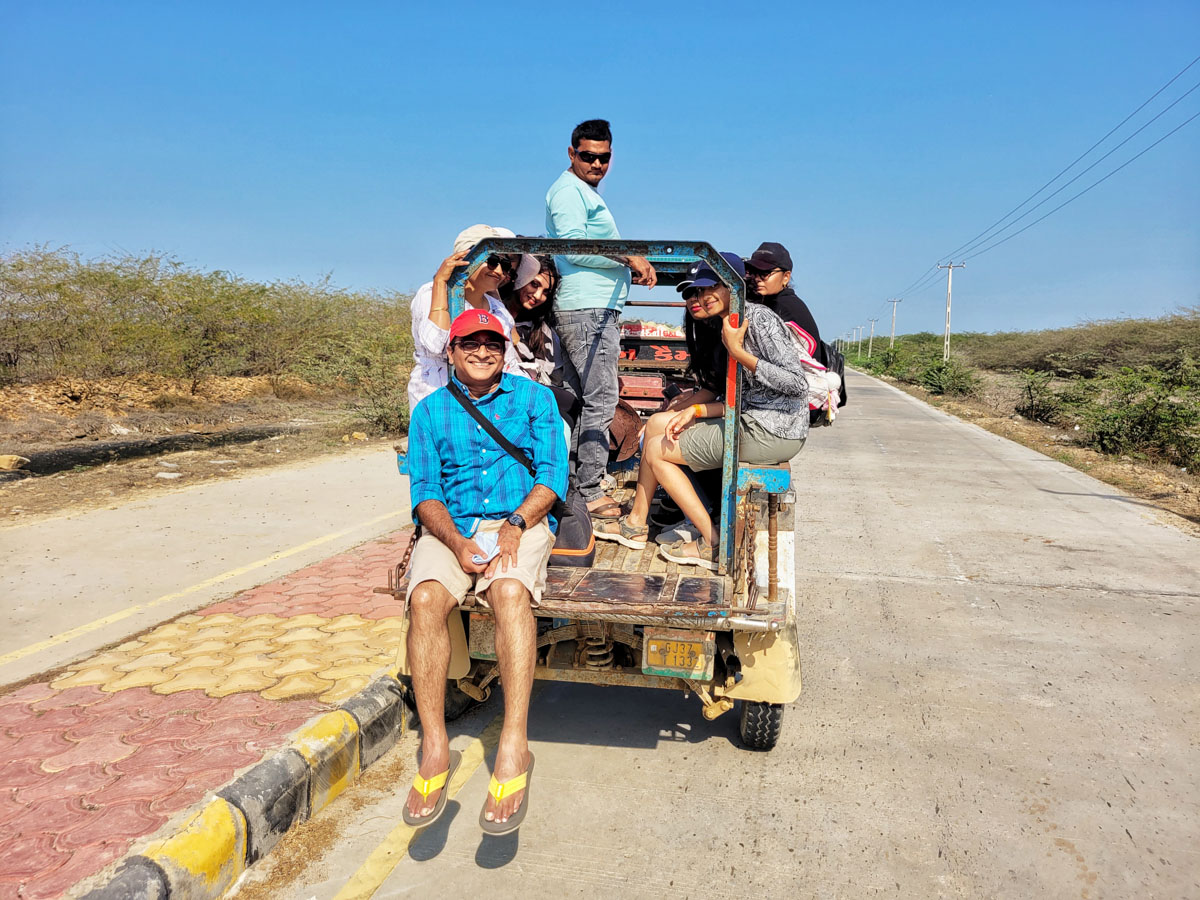
A few decades later, I found myself aboard a 'chakda' again, relishing the experience with pure joy
The thriving marine life of Beyt Dwarka
Guided by Rahul, a marine biologist from the camp, we ventured into the shallow water bodies enveloped by a lush green landscape. Walking within the water amid lilies and patches of mud, we delved into the mysteries of marine life.
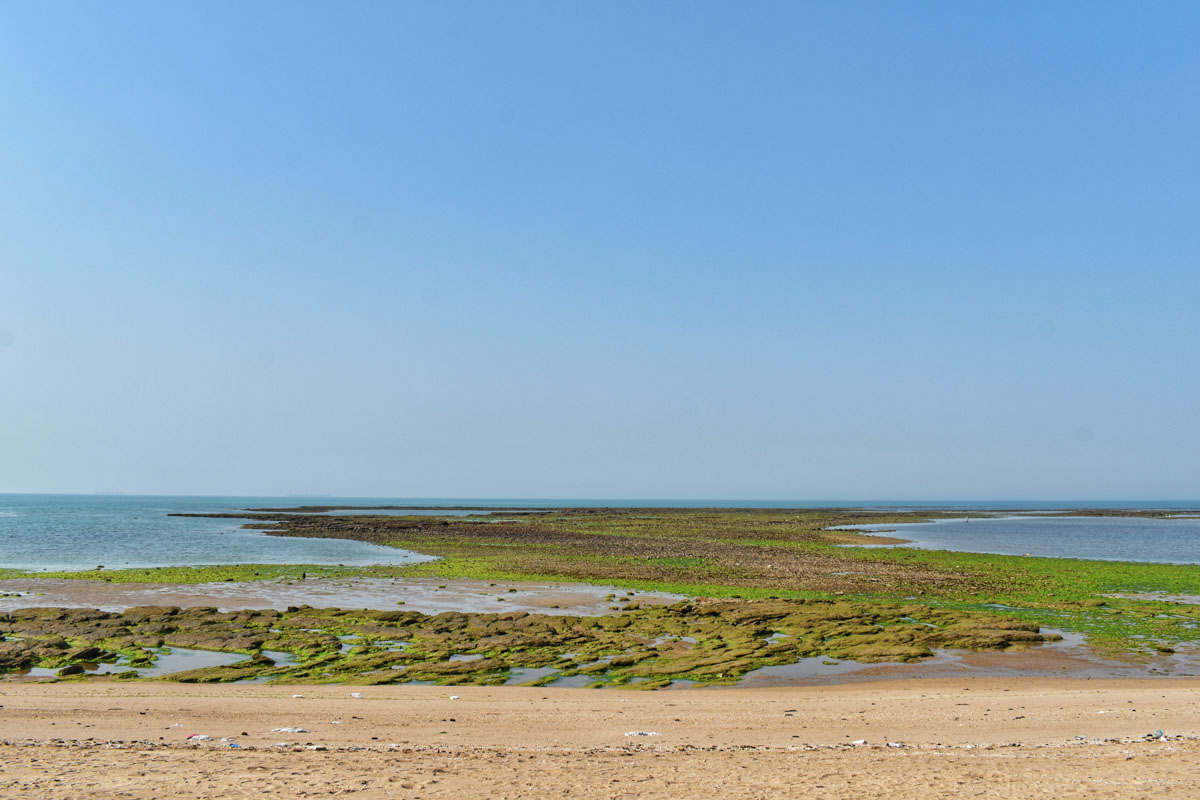
The picturesque beach where we embarked on our marine exploration
To my astonishment, the shallow waters teemed with an incredible variety of marine animals, some of which were entirely new to me. Among the fascinating creatures we encountered were brain corals, sea sponges, prawns, rock crabs, sea hares, sea crabs, sea anemones, starfish, octopuses, and sea feathers. It was a revelation, a vibrant ecosystem thriving in the seemingly serene shallows of Beyt Dwarka. For a visual experience of this exquisite marine life, I encourage you to view the video below, capturing the marvels of Beyt Dwarka's underwater world.
Our guide Rahul from Nandanvan Camp leads us on a marine life exploration in the shallow waters of Gulf of Kutch
Among the many wonders we encountered, the sea hares and sea anemones were the most captivating. Sea hares (also called sea rabbits) are fascinating marine creatures that lack bones and move at a leisurely pace. However, Mother Nature has endowed them with a remarkable and potent defense mechanism to protect themselves from predators. When sensing danger, they can release a dark-purple, adhesive ink into the water, which rapidly spreads over a few meters. This ink temporarily impairs the vision of potential threats for approximately 10 minutes, providing the sea hares with a vital window of opportunity to retreat to safety. It's a stunning example of nature's ingenious adaptations for survival.
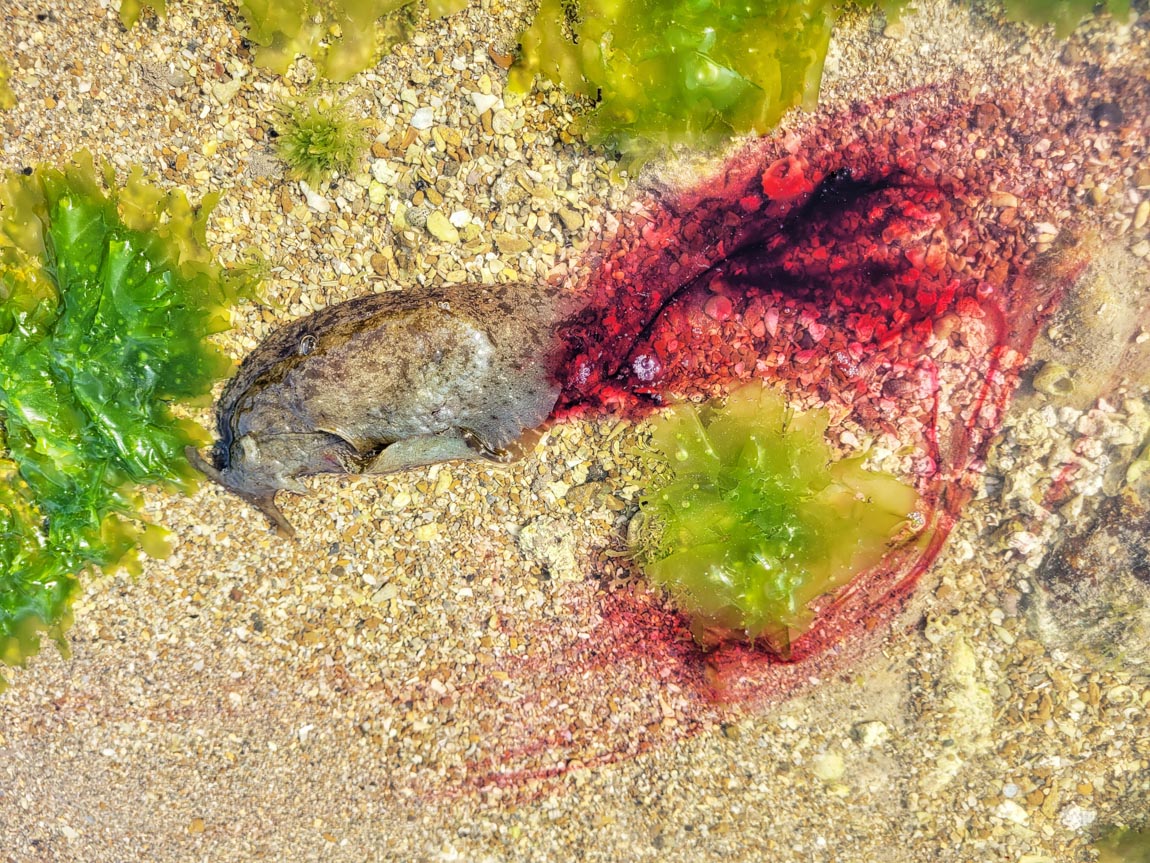
A sea hare (Aplysiida) displaying its natural instinct for self-protection against predators
The Sea Anemone is a unique marine creature that often goes unnoticed by the naked eye. Resembling coral or vegetation, it peacefully floats on the water's surface, appearing motionless. However, its appearance belies a remarkable hunting technique. With an incredibly long and agile tentacle that extends several feet beneath the water, the Sea Anemone swiftly seizes its prey, typically fish or crabs, in a fraction of a second as they pass overhead. The creature engulfs its catch, vanishing beneath the sea before one can even blink. After a few minutes, it resurfaces, expelling the bones into the water, readying itself for another hunt.
Rahul pointed out a discarded crab skin, illustrating how crabs shed their entire exoskeleton multiple times during their lives. During this vulnerable period, they temporarily lose their defense mechanisms and, as a protective measure, burrow into the mud to shield themselves from predators. It takes several weeks for the crab to regenerate its outer layer, ensuring its safety while it undergoes this natural process of growth and renewal.
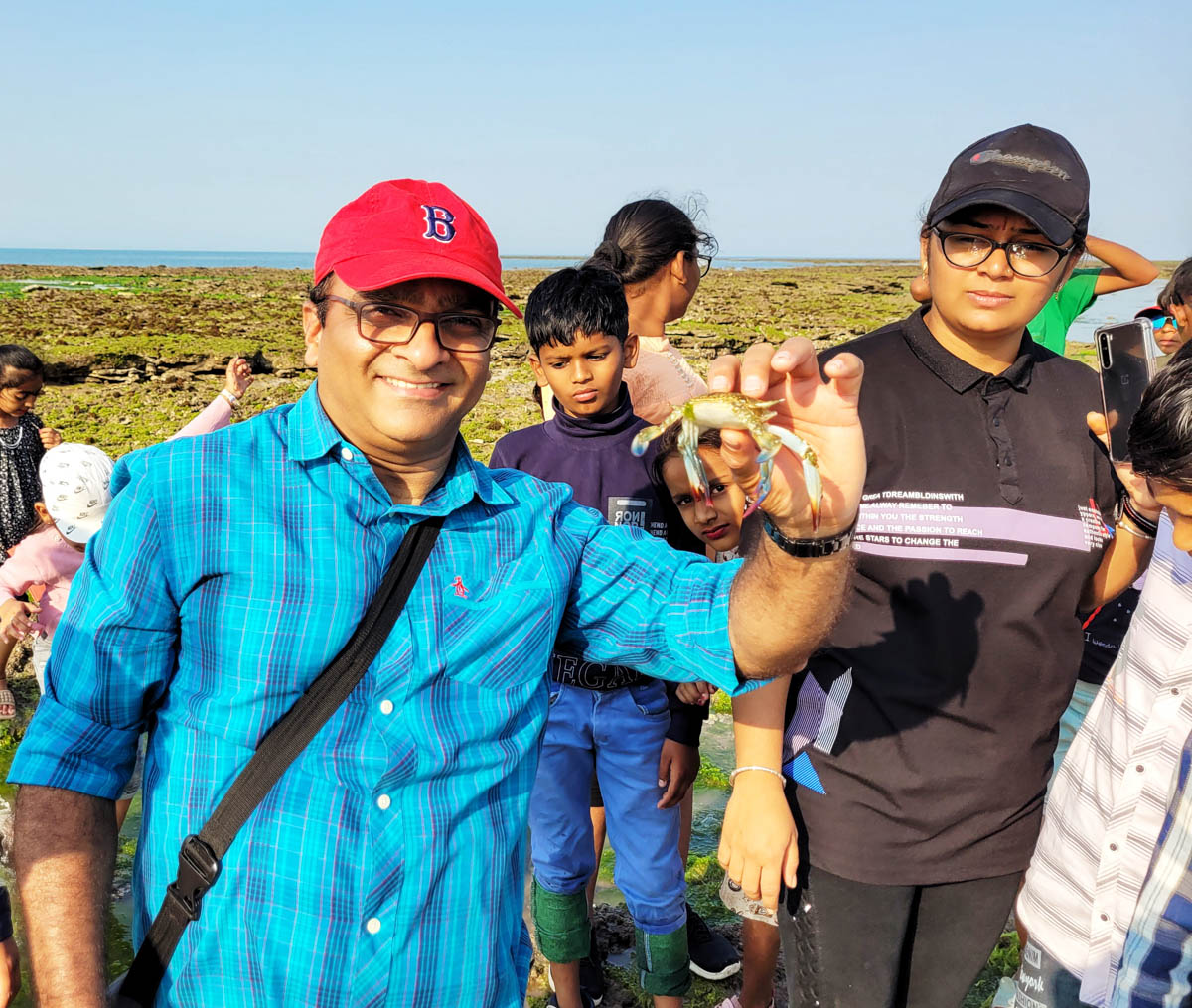
Spurred on by the children's enthusiasm, my inner child also yearned to strike a pose with a crab's exoskeleton
The afternoon session spent exploring Beyt Dwarka's distinctive biodiversity was truly exhilarating. According to Rahul, what we witnessed merely scratched the surface of the diverse marine life here. Due to the unexpected rise in temperature, marine animals had retreated deeper into the water to escape the heat. Rahul recommended visiting during the winter months, starting from November, as it is the ideal time to witness a richer display of marine life when the creatures are more active and visible.
Makardhwaj Temple - Birthplace of Lord Hanuman's Son
It was time to return to the camp, but not before paying our respects at two of Beyt Dwarka's most revered temples. The first among them was the Makardhwaj Temple, also known as Hanuman Dandi. This temple holds a unique distinction as it's the only one in the country dedicated to Makardhwaj, the son of Lord Hanuman. Given Lord Hanuman's celibate nature, the legend surrounding Makardhwaj's birth is intriguing. It is believed that when Ravana set Hanuman's tail ablaze in Lanka, Hanuman doused the fire in the ocean. During this incident, a drop of his sweat was swallowed by a fish, leading to the birth of his son from the fish. The temple is revered as the birthplace of Makardhwaj, drawing devotees seeking blessings for strength, courage, and protection. Its serene ambiance and profound historical significance make it a cherished destination for pilgrims. It is believed to be one of the few temples where both father and son are seated together.
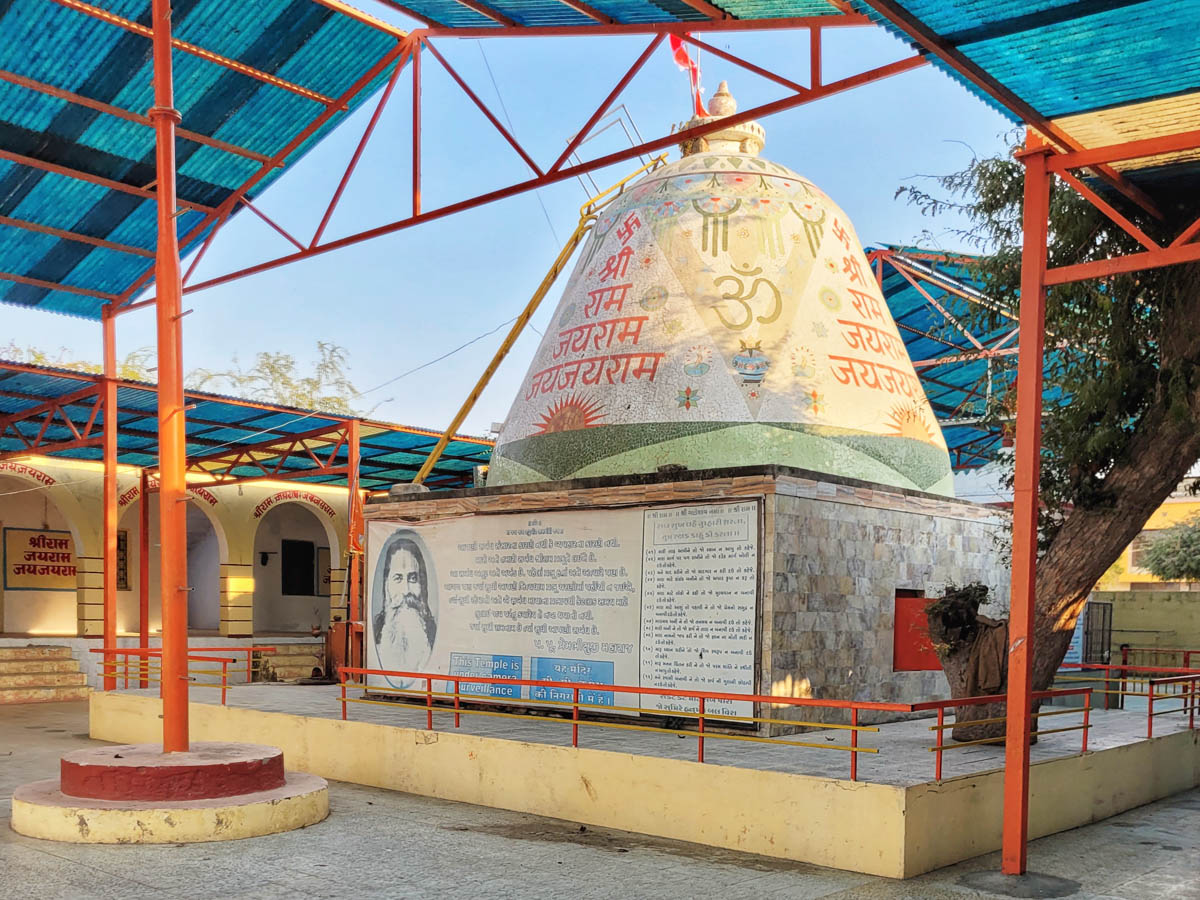
The sacred Makardhwaj temple located on Beyt Dwarka
Shri Keshavrai Ji Temple - the Soul of Beyt Dwarka
Our next stop was the Shri Keshavrai ji Temple, the principal religious site in Beyt Dwarka, attracting millions of pilgrims annually. This temple carries immense historical significance, believed to be the very abode where Lord Krishna once resided. Nearly 500 years ago, Vallabhacharya established this sacred place. The original idol, believed to be consecrated by Devi Rukmani, one of Lord Krishna's main queens, bears a striking resemblance to the one in Dwarka's main temple. The only distinction lies in the conch held by the idol, positioned obliquely.
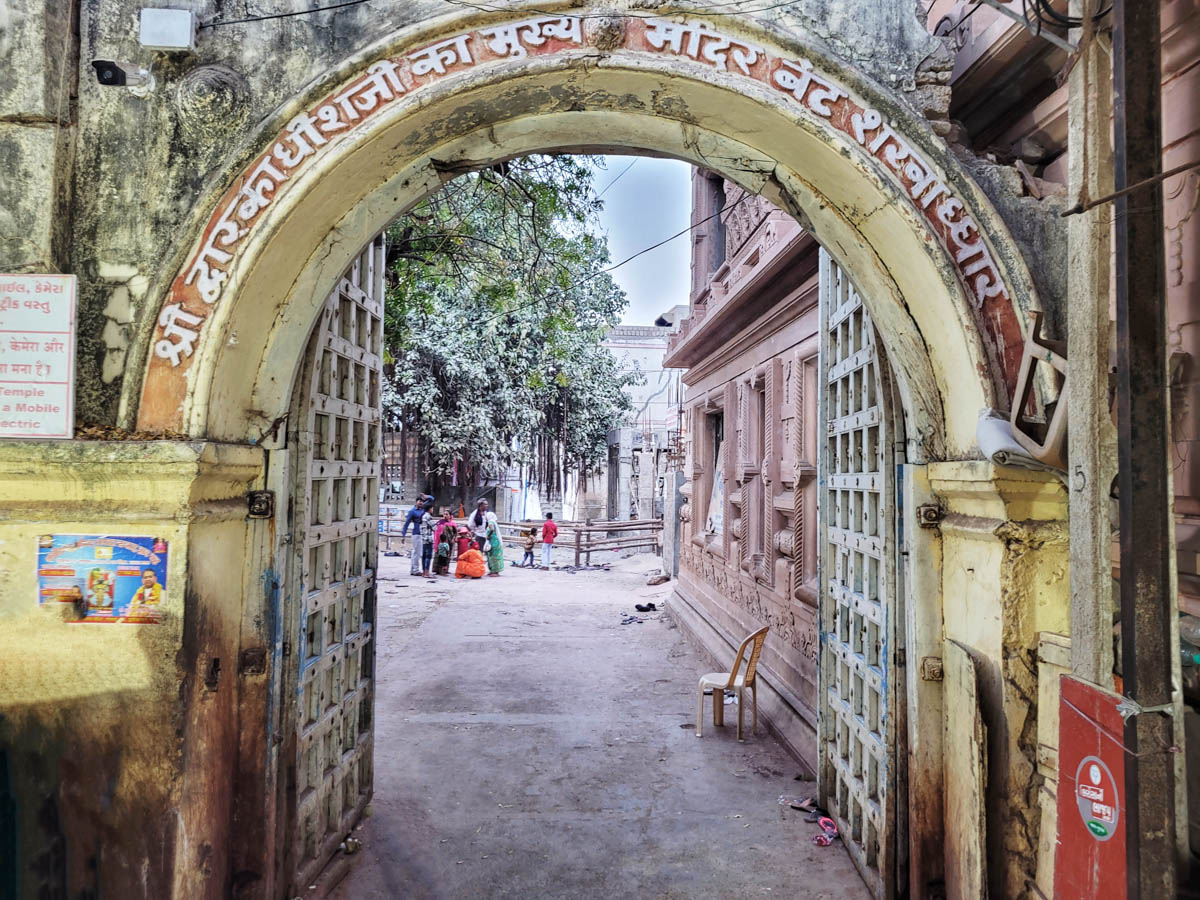
The entrance to Shri Keshavraiji temple on Beyt Dwarka
In this temple, rice is the primary offering, symbolizing Sudama, Lord Krishna's childhood friend who gave him rice as a gift. Adhering to temple customs, visitors must ensure their knees and shoulders are modestly covered before entering. Mobile phones are prohibited within the temple premises. Unaware of these rules, we arrived in shorts, having come directly from the sea after our marine exploration. Fortunately, a nearby Gaushala (shelter for the cows) provided us with dhotis to meet the dress code. While no payment is demanded for this service, it is customary to make a donation, contributing to the welfare of the cows.
With the temple visits concluded, it was the perfect moment for a bit of retail therapy. The temple's vicinity was bustling with numerous shops, offering an array of handicrafts, Krishna idols, and intriguing items. Traditional clothing resembling what Lord Krishna wore during his childhood is also available, making it an excellent spot for souvenir shopping. Additionally, a selection of street food outlets awaits, inviting those interested in tasting some local delicacies.
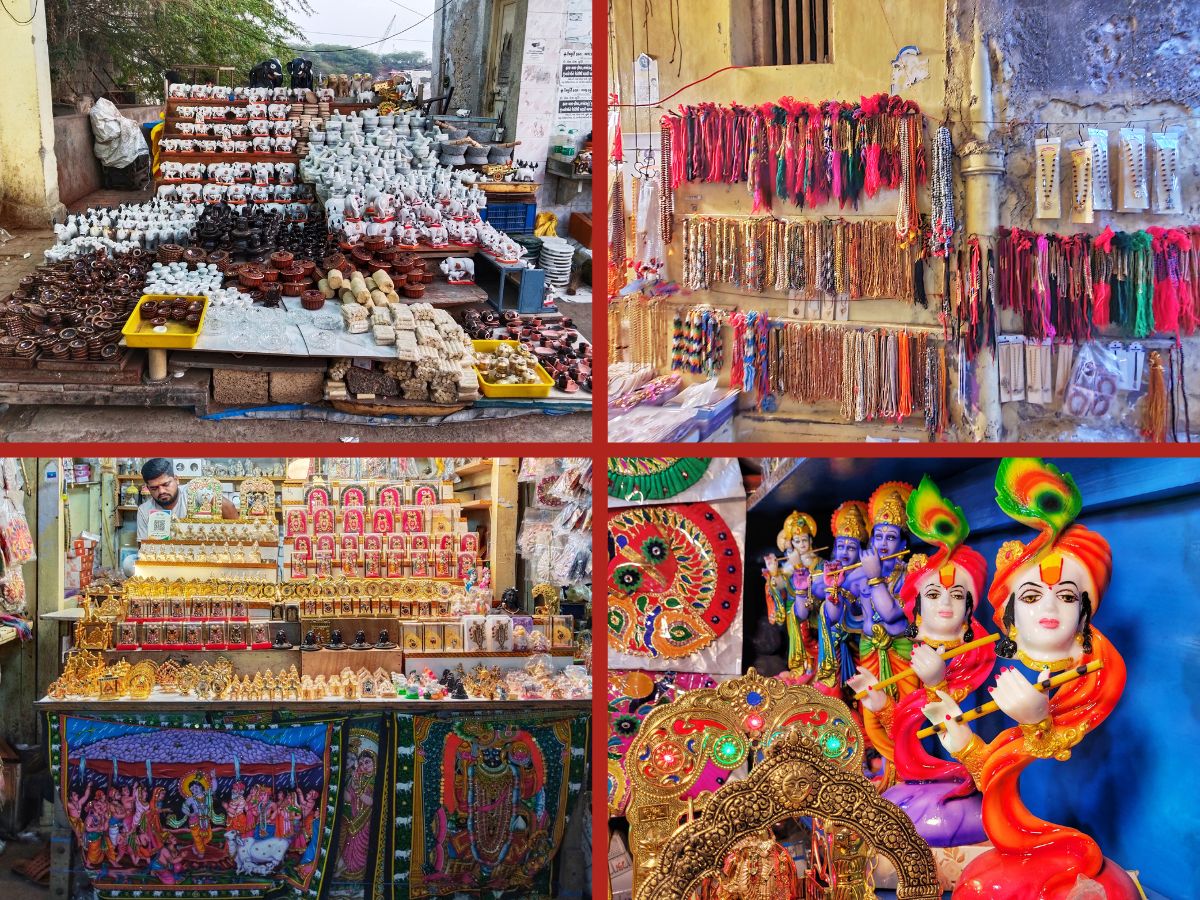
Beyt Dwarka has a variety of shops selling souvenirs, jewelry, conchs, and Krishna idols
We made our way back to the camp utterly worn out. True to our expectations, dinner was basic yet incredibly flavorful. While I was longing to retire to my bed, the children were still brimming with energy, ready for a night of festivity. The camp management arranged a music system, and kids eagerly engaged in garba dancing to the melodies that filled the night air. The air was filled with anticipation as we looked forward to the exciting day ahead, which would take us deep into the ocean on a dolphin-watching adventure aboard a large boat.
The sunrise at Nandanvan Camp paints a mesmerizing picture you wouldn't want to miss. The sun's vibrant orange hues gracefully caress the beach sand, casting a warm glow upon the tents and trees, transforming the entire campsite into patches of gold. From a distance, the entire scene appears as if nature itself is basking in the morning light. The serene ocean below the hill amplifies the beauty of the sunrise, adding a touch of dramatic elegance.
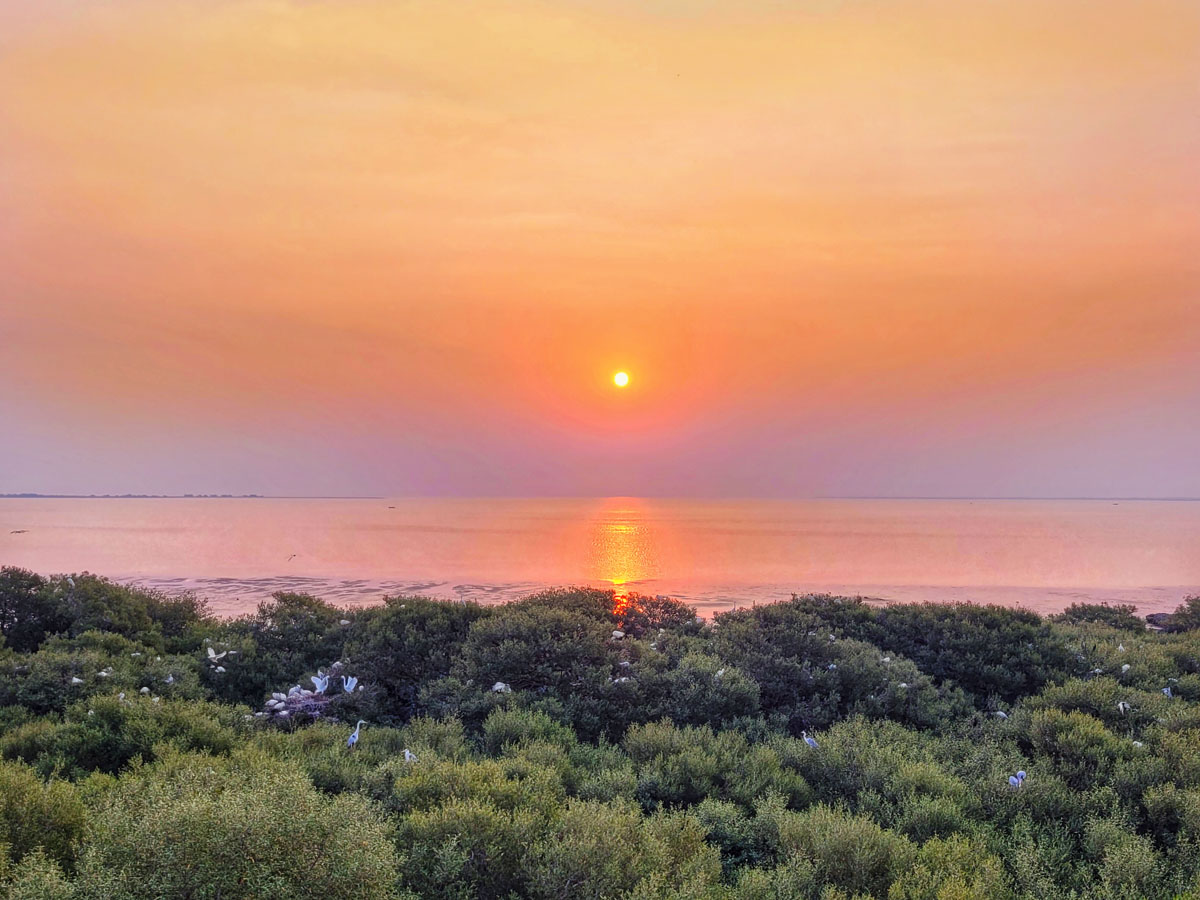
The beautiful sunrise at Nandanvan Camp was also accompanied by birds' graceful melodies
What captivated me even more was the opportunity to observe the early morning rituals of the water birds nesting in the nearby trees. Positioned parallel to the hill where the camp is nestled, these treetops offered a perfect vantage point. With my camera in hand, as a dedicated birder, I was prepared not to miss a single moment of these enchanting avian activities.
The trees below Nandanvan Camp are filled with hundreds of nesting birds
The trees were adorned with a myriad of bird species, including Black-headed Ibises, Gulls, Gray Herons, Great Egrets, Cormorants, and Pond Herons. The air resonated with a continuous symphony of clatter and chirping, as if the birds themselves were celebrating the arrival of the sunrise. Parent birds made incessant flights, diligently bringing food for their offspring. The sight of hundreds of nests adorning the trees was nothing short of captivating. I found myself utterly engrossed, my feet refusing to move, my camera shutters clicking away, until the call for breakfast finally pulled me away.
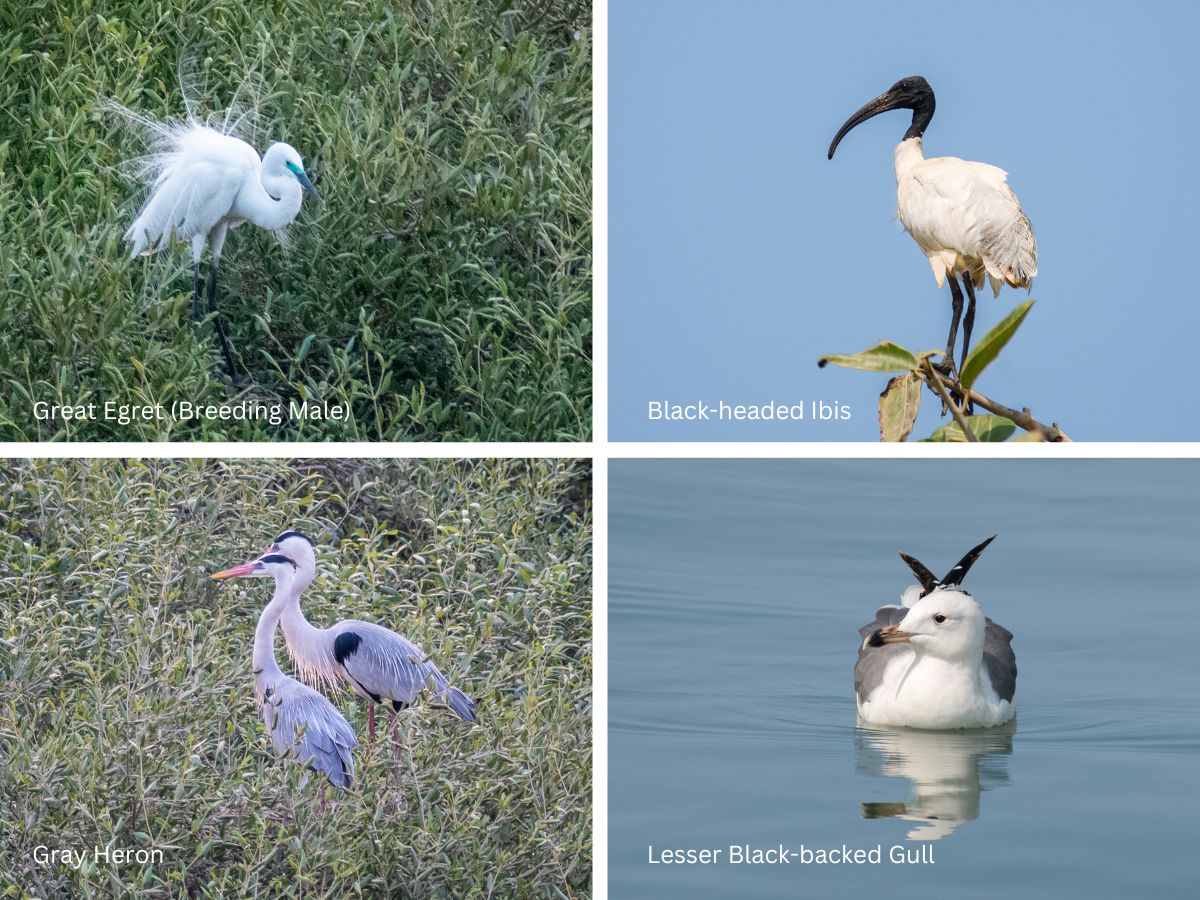
Bird species often sighted at Nandanvan Camp
Dolphin Watching
Our bags were packed, and we were preparing to board a boat that would take us far into the ocean for a dolphin-watching adventure. Our lunch was carefully packed as we planned to enjoy it amidst the vastness of the ocean. The same boat was slated to bring us back to Okha jetty. Excitement filled the air, particularly among the children. They had been briefed by marine biologists to make loud cheers upon spotting dolphins, a contrast to the silent demeanor required during our previous day's marine life exploration. Dolphins, known for their playful nature, revel in human company. After attending a presentation about dolphin behavior the previous night, the kids were ecstatic.
Descending the hill from our campsite, we strolled toward a tranquil beach where a smaller boat awaited us. Boarding the smaller boat, we made our way to the larger boat anchored a bit farther in the deep waters. Our exciting journey began aboard the larger boat amid cheerful laughter and spirited garba dancing by the schoolchildren, generating an electrifying atmosphere.
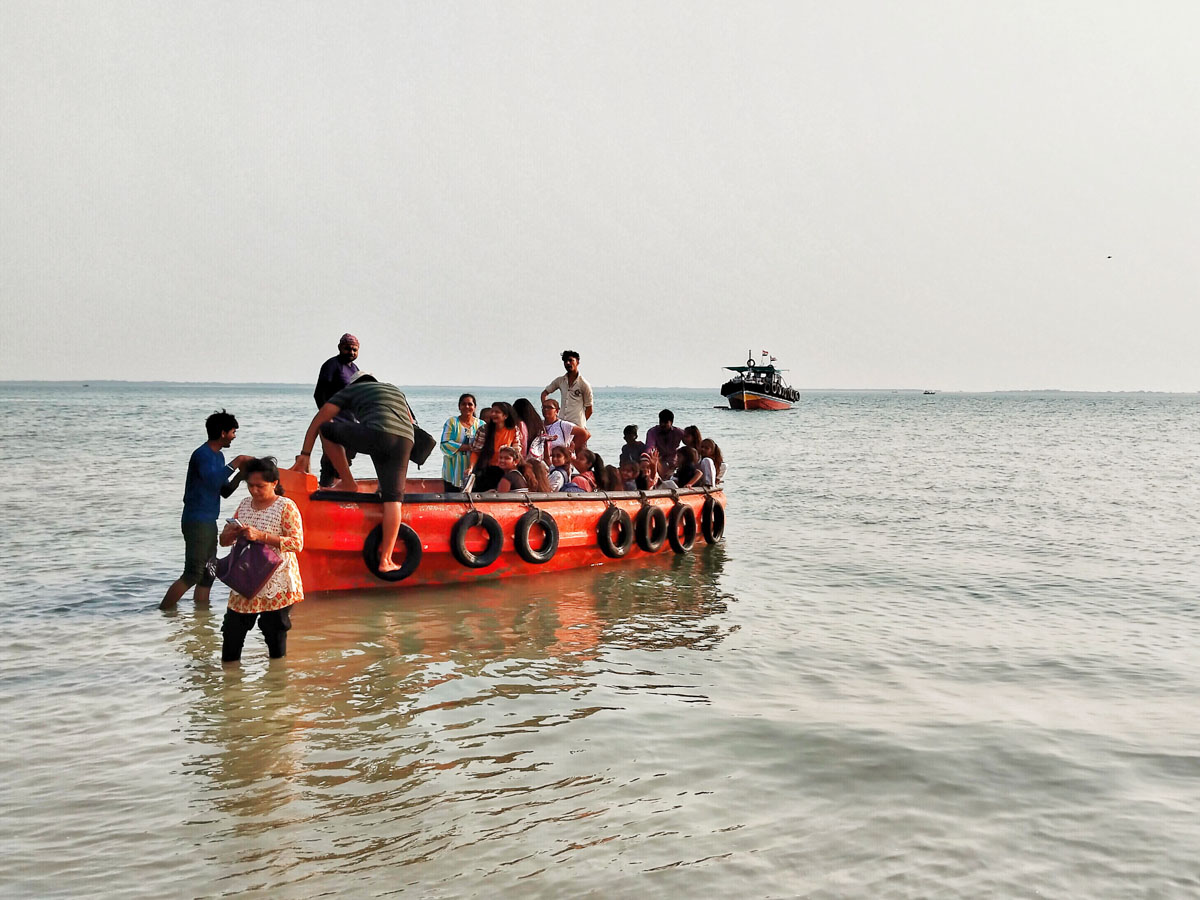
Stepping onto the smaller boat that would ferry us to the larger boat anchored in deeper waters
At last, we arrived at the dolphins' dwelling grounds. The sight of dolphins leaping gracefully from the water sent the kids into a frenzy of excitement. Their enthusiastic cheers were ceaseless, matching the dolphins' exuberance as they playfully circled our boat for an extended period, providing us with immense satisfaction for our lengthy voyage to witness them.
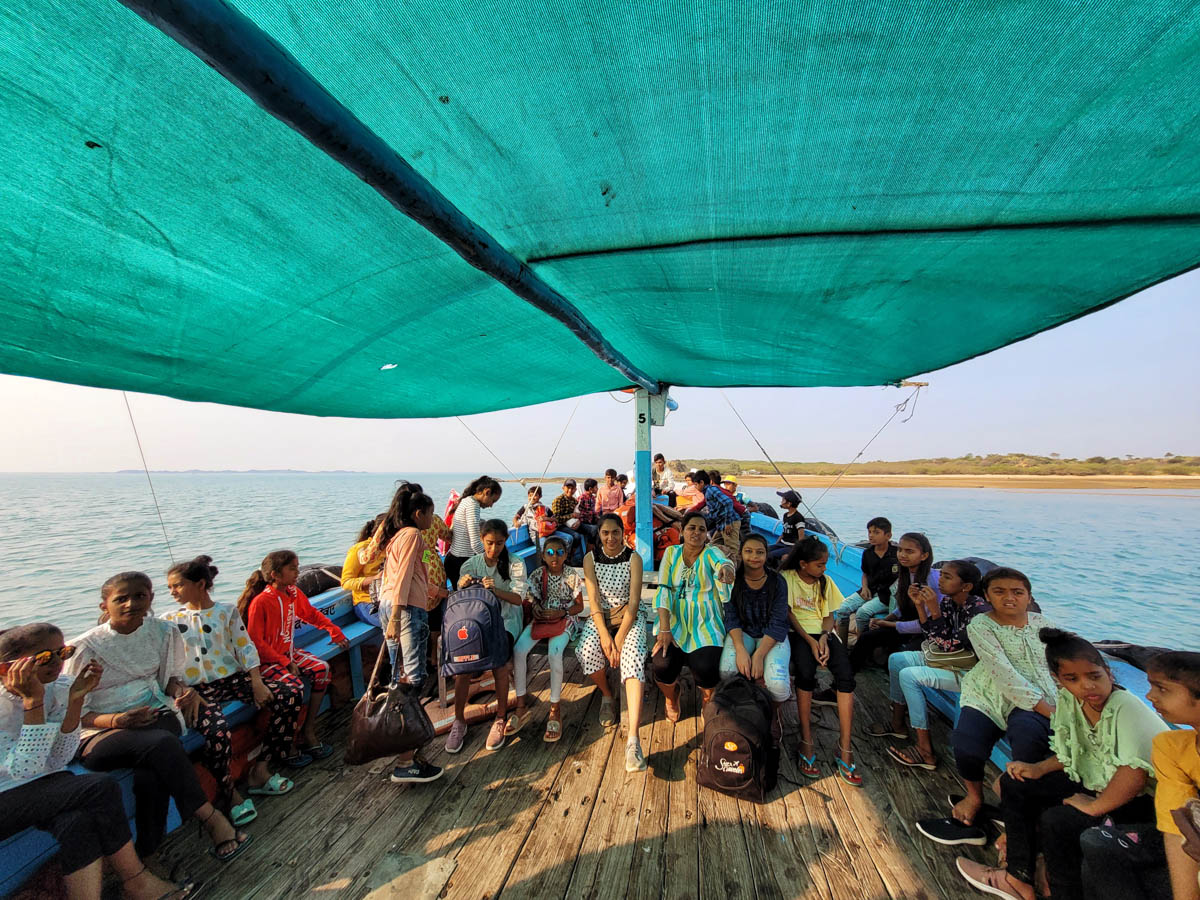
The kids loved the boat ride, eager to see dolphins
This region boasts a population of over 350 dolphins and approximately 50-60 olive ridley turtles. However, due to the warm weather, the turtles had retreated deep into the water, eluding our sight. We learned that winter offers the best opportunity to spot turtles, as they remain near the surface and exhibit increased activity. After a delightful lunch onboard, we made our way back to Okha jetty, marking the conclusion of a thrilling and adventurous segment of our journey.
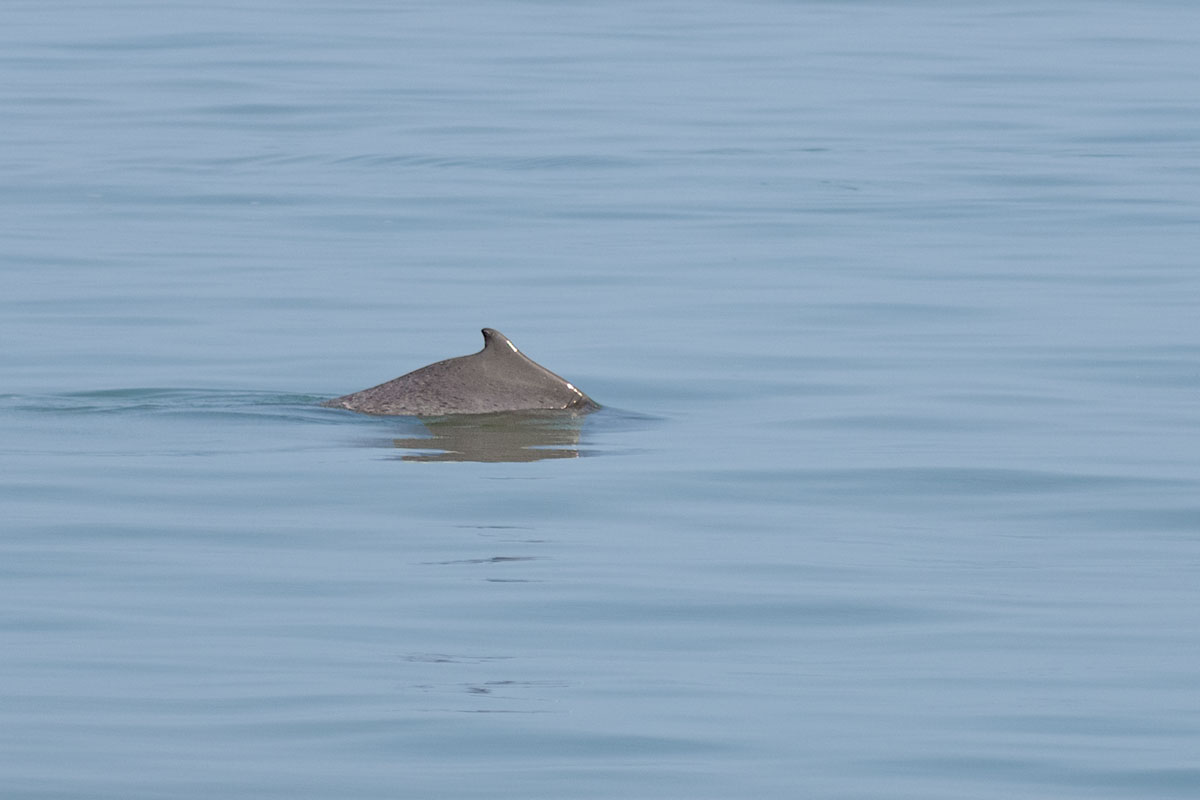
Dolphin swimming close to our boat
The nostalgia revisited
Having exchanged heartfelt farewells with the children and their teachers, we parted ways, each of us heading down separate paths from that point on. The encounter was exhilarating, not just because of our interaction with the marine wonders but also due to the vibrant presence of the schoolchildren. As we set out on the road back to Rajkot, a wave of nostalgia washed over us, reminiscent of our own school days, adding a touch of sentimentality to our journey.
Frequently Asked Questions:
How do I reach Beyt Dwarka?
You can reach Beyt Dwarka by ferry from Okha. There is a ferry service between Okha and Beyt Dwarka every day between 6 am and 7 pm. The 15-minute boat ride offers scenic views and an exciting approach to this hidden gem. There is good rail and road connectivity to Okha. Rajkot and Jamnagar are the nearest airports.
Are there any restrictions on visiting Beyt Dwarka main temple?
Wear modest clothing that covers your knees and shoulders when visiting the Beyt Dwarka main temple. The temple does not remain open throughout the day, so be aware of its opening hours. Please note that cameras and mobile phones are not allowed inside the temple.
What are the ferry charges and timing to get to Beyt Dwarka?
A one-way ferry ticket to Beyt Dwarka costs INR 20 per person. Group charter bookings are available for convenience. Negotiate the price directly with the boatman. There is no set schedule; the boat departs as soon as enough passengers board. The ride takes approximately 15-20 minutes. Ferries operate daily between 6 am and 7 pm, although weather conditions may alter these timings.
Where to stay in Beyt Dwarka?
There are no hotels in Beyt Dwarka, as most visitors prefer to pay homage to the temples on day trips. However, for nature enthusiasts and students, Nandanvan Camp offers basic accommodation options. Those seeking a deeper connection with nature will find that this camp provides a unique experience in nature.
Disclaimer: This blog may contain affiliate links. At no extra cost to you, we may get a small commission if you buy anything. All products and services we endorse have been personally used or come highly recommended to us. These incomes allow us to keep the community supported and ad-free.


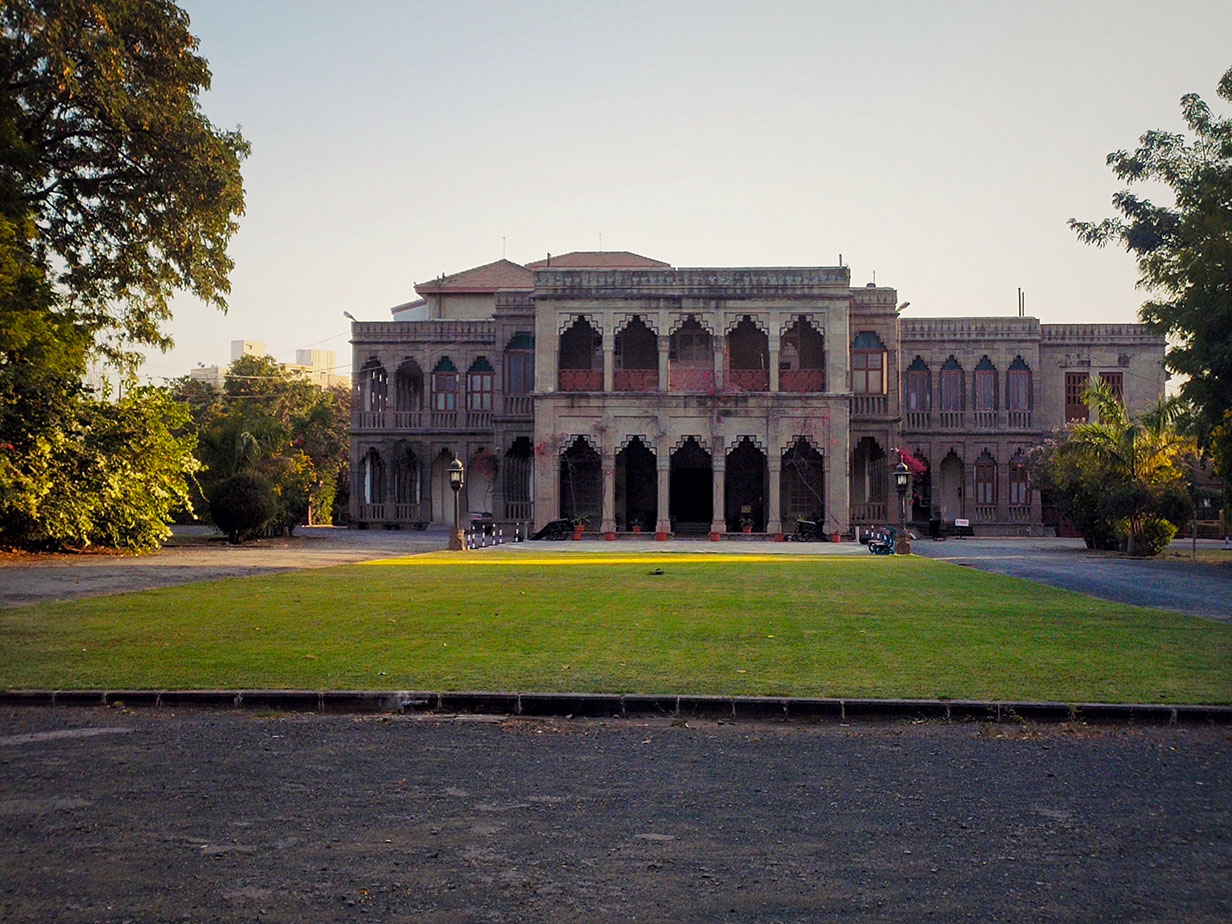
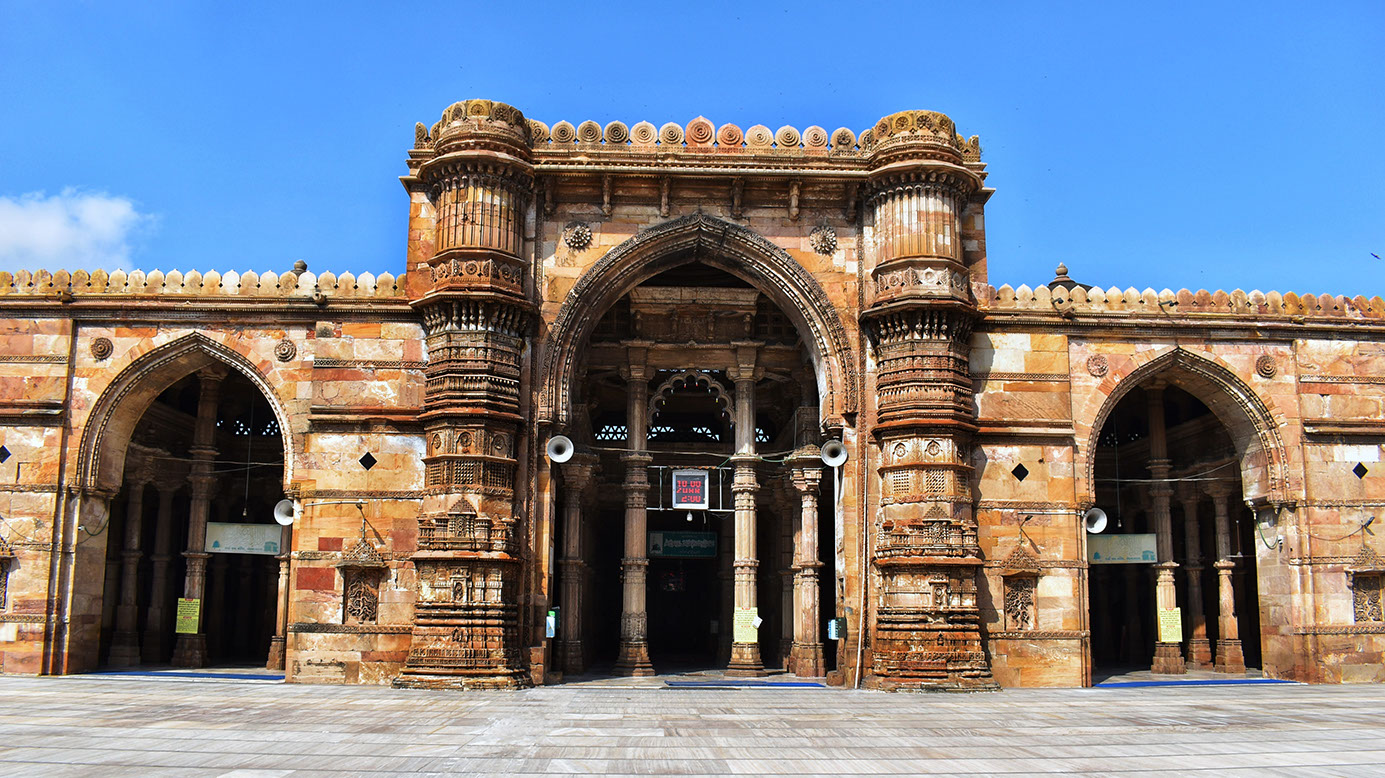
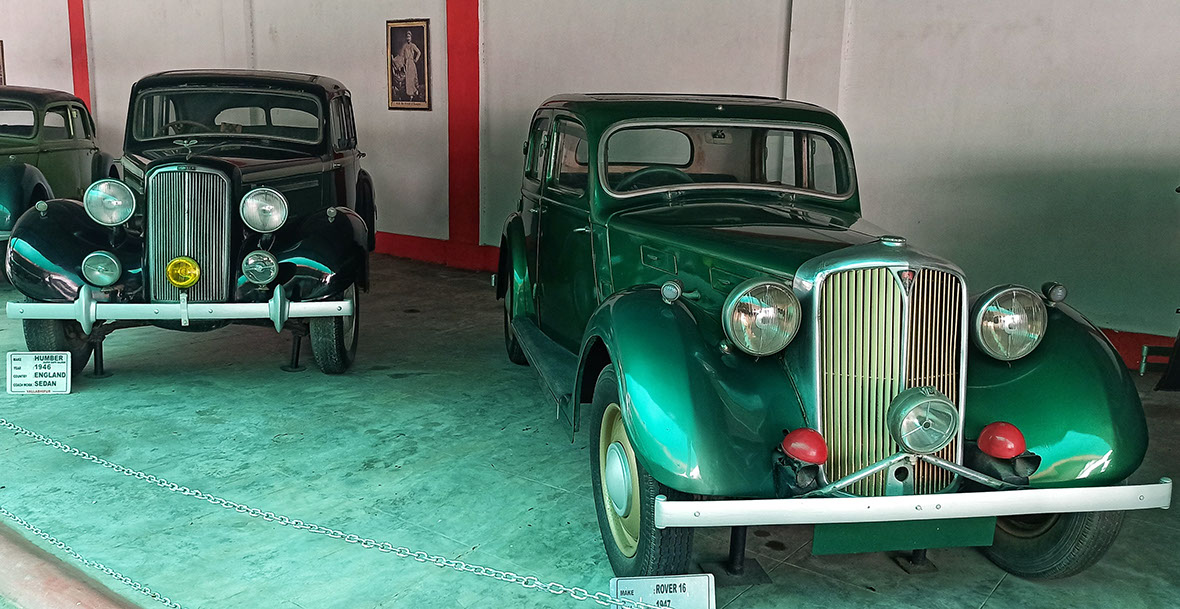

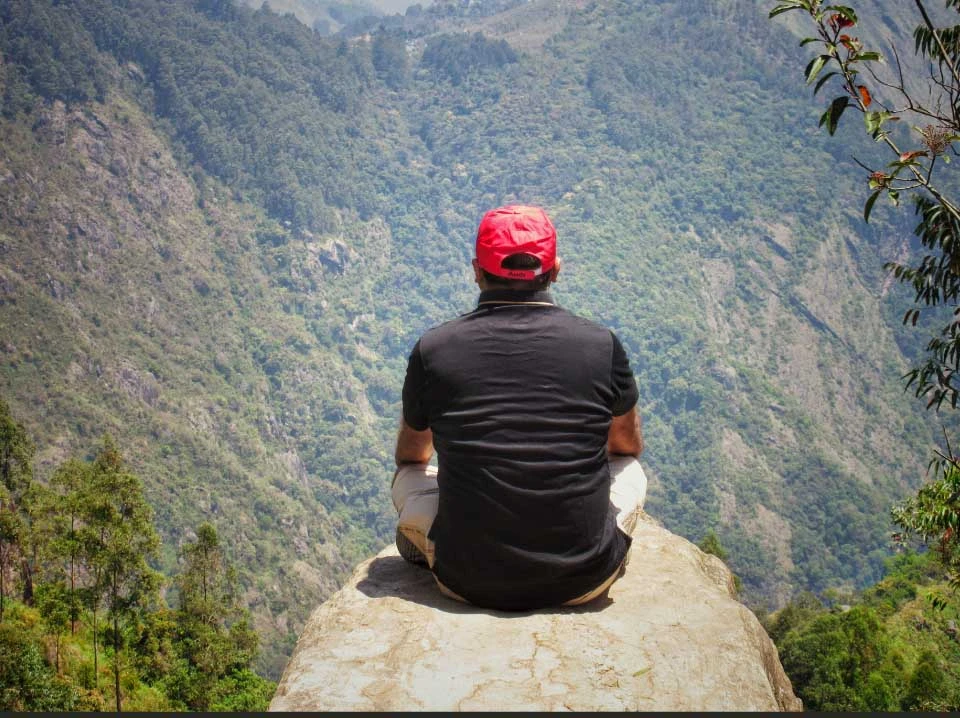
Name
Email
Comment